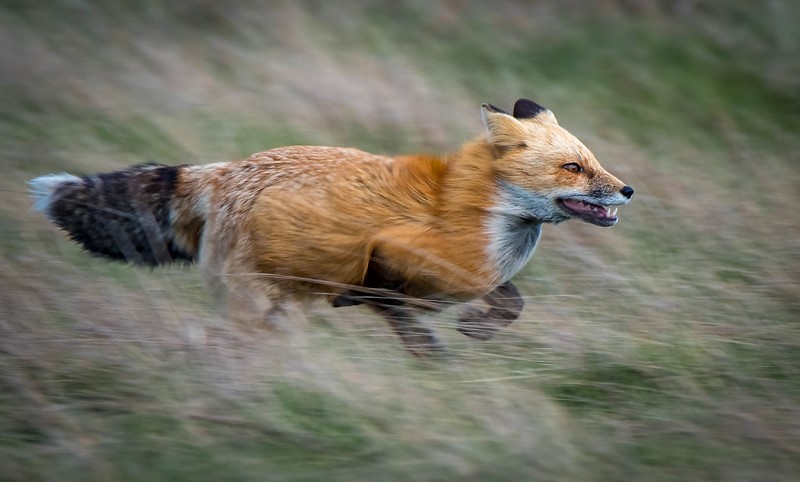
Foxes are highly adaptable and found on every continent except Antarctica. They live in both rural and urban areas, even living among humans. Over time, fox sightings have been more common in many regions of the United States.
With the possibility of spotting them in your yard, out on a hike, or at the park – foxes will be fascinating to observe. But what makes them so interesting? Are you curious? Let’s look at some of the most exciting and lesser-known facts about these canny creatures.

Foxes are related to dogs.
We know you’ve thought about this, too: foxes and dogs resemble each other. Well, we won’t break it to you! Foxes are members of the Canidae (dog family), including wolves, coyotes, and domestic dogs. They’re part of the Vulpes genus and have adapted to various habitats and lifestyles. Some fox species are considered endangered due to their decreasing numbers or limited habitats.
Like a cat’s eye, their pupils are vertical, enabling them to see well at night.
When you look at a fox, it’s natural to be intrigued by its fierce aura. But their eyes are more than an aesthetic feature. Foxes have vertical pupils, like cats and other nocturnal animals. This helps them to be more active during the night, allowing them to see clearly even in low-light conditions.
They have 40 sounds.
You may have heard fox songs before – a chorus of high-pitched barks that echo through the night. But did you know that foxes can make more than 40 sounds, from a warning bark to a playful yip? Foxes use their vocalizations to communicate with each other about food and predators and even for courtship.

Bat-eared foxes listen for insects.
The aptly-named bat-eared foxes are unique among their types. Unlike other foxes, they don’t rely on their sense of smell or sight to find food. Instead, they have huge ears that help them listen for insects like termites and beetles in the ground. These large ears even act as a cooling system, helping bat-eared foxes to regulate their body temperature in hot climates.
The whiskers on foxes’ legs and faces help them navigate.
Whiskers are present in almost all mammals. But have you wondered what they are for? It’s not a surprise, but foxes have more than just two ears, too- they’re equipped with whiskers. It adds an extra layer of sensory input to the fox’s already impressive senses. Foxes use their whiskers to help them navigate dark and complex environments, such as burrows or thickets. They can also detect changes in air pressure, allowing them to detect nearby prey.
Red and Grey foxes have different colors of fur.
Foxes come in all sorts of colors, from white to black. But the most common color for foxes is either grey or red. Red foxes have thick, orange-red fur, whereas grey foxes have charcoal-colored coats with flecks of yellow and brown. Both species can be spotted during the day, but their coat color helps them blend into their environment and stay camouflaged from predators.

Foxes are fast
Foxes resonate with their intimidating aura, and… they do not disappoint! They are quick animals and can reach speeds up to 70 mph! That’s six times as fast as a human running. Foxes use their speed to chase down prey and outrun predators. But even with their lightning-fast speed, foxes are incredibly agile and have an excellent sense of balance.
Cats and foxes share many characteristics.
It is not only their visual resemblance that ties cats and foxes together. Foxes have retractable claws and sharp teeth, just like cats. While it’s uncommon for most dogs to climb trees, foxes exhibit this trait, further proving cat-like features. And as mentioned previously, foxes have eyes that contract into a vertical slit like cats do to help them see better in the dark.
Foxes are solitary.
Foxes and wolves belong to the same family. However, foxes differ when it comes to their social behavior. They are primarily solitary animals, but they do form family group units. While adult foxes generally live and hunt alone, male and female pairs can be spotted together when the breeding season rolls around. They may also share a den to raise their pups in the spring and summer. This makes foxes different from other male animals since others do not help raise offspring.
A fox uses the Earth’s magnetic field for navigation.
Foxes have a unique sense of direction and use the Earth’s magnetic field to help them find their way. They can detect the subtle changes in the magnetic field, helping them orient themselves and navigate unfamiliar territory. This ability comes in handy for long-distance travel, giving foxes an edge when searching for food or finding new den sites.
Fox cubs play can get violent.
While a fox cub may look like little bundles of fur, they can actually get quite aggressive. Fox cubs are known to play fight with each other. This behavior might seem cute and playful, but it helps them practice essential hunting and self-defense skills they need as adults.

Foxes weigh less than 3 pounds on average.
Foxes may look large and intimidating, but they weigh less than 3 pounds on average. The most common fox species in North America is the red fox, which can weigh anywhere from 10 to 30 pounds. On the other hand, the fennec fox is the smallest species. Fennec foxes usually weigh in at just 2 or 3 pounds!
Their shivering occurs only when the temperature reaches -94°F (-70°C).
When temperatures drop, foxes start to shiver to stay warm. But interestingly enough, this behavior only occurs when the temperature reaches -94°F (-70°C). Any colder than that, and they simply curl up in a ball to stay warm until temperatures rise again.
Climate change is hurting Arctic foxes.
Unfortunately, climate change is taking its toll on Arctic foxes. As the temperature rises and polar ice melts, their food sources become scarcer, and their habitats are shrinking. Over the past few decades, this has decreased Arctic fox populations, and conservation efforts are needed to ensure these unique animals don’t go extinct.
It is believed that foxes are sneaky.
You might’ve heard “sly fox” thrown around, and it’s no surprise why. Foxes are known for their cunning behavior and reputation for being sneaky. This is due to their ability to use their environment to outsmart predators, hide from hunters, and even skulk into human dwellings in search of food. It’s safe to say no one is as determined and as leash as these foxes!

They have a high level of athletic ability.
Foxes have impressive athletic abilities. They can jump up to three feet high, run at speeds of over 60 mph, and even swim in cold water if needed! Not only that, but foxes are also incredibly agile and have an excellent sense of balance.
In the snow, foxes are famous for pouncing on mice and other rodents digging in the fields. Contrary to the brave wolves, foxes are omnivorous, eating animal and plant matter. Some fruits included in their diet are berries, cherries, grapes, plums, and persimmons.
There is an extra toe on their forepaws
Foxes have an extra toe on their forepaws, which helps them grip prey and make sharp turns while running. This special adaptation is known as “dewclaw” and sets foxes apart from other canids like wolves or coyotes.
Foxes Have Ultrasonic Hearing That Can Hear A Ticking Watch 40 Yards Away
Foxes have an incredible sense of hearing that helps them catch their prey. They can listen to a broader range of frequencies than humans and have what’s called “ultrasound detection.” This means that foxes can hear objects up to 40 yards away! A ticking watch or a small animal scurrying across the ground won’t escape the ears of a fox. No wonder tiny how tiny, quiet rodents reach their demise!
They Can Be Found in More Than 80 Countries.
Foxes can be found in over 80 countries and on every continent except Antarctica. They have adapted to different environments, from the Arctic tundra to deserts, and even live among humans in urban areas. No matter where they are located, foxes always manage to find a way to survive!

Foxes live in underground dens.
Foxes also exhibit intelligent and resourceful behavior. They like to live in “earths” or dens that they dig themselves or take over and modify burrows created by other animals. These dens can be underground and typically have several entrances and exits that can be as long as 75 feet.
Both mother and father foxes use these dens for shelter, protection from predators, fox hunting, and raising their kit (baby foxes). These kits are around 4 or 5 in number, depending on the species.
Foxes are known to be smelly.
Foxes may be cute, but they definitely aren’t known for their pleasant smell. Foxes have a strong musky odor from the oils they secrete to mark their territories and ward off predators. But don’t worry- this smell won’t linger around your house unless you have a fox living in your basement!
The scent they release is called the violet gland, situated at the base of their tail. They use this scent to signal other foxes from their species and are used for scent marking.
Like cats, foxes can retract their claws.
As mentioned, foxes have an extra toe on their forepaws, which helps them grip onto prey and make sharp turns while running. This adaptation allows them to move quickly over rough terrain without damaging their paws or feet.

Red foxes have white tips on their tails, while swift foxes have black tips.
If you spot a fox in the wild, look for clues that can help you identify its species. For example, red foxes have white tips on their tails, while swift foxes have black tips and tend to be much smaller than other species.
Red foxes are the largest fox species, and they’re also one of the most common species. Their snouts are pointy, and their face, back, and tails are red. Hence, named Red Fox. The other parts of their body, from the front neck and belly, are grayish-white. With their numbers, they are listed as “least concern” by the International Union for Conservation of Nature (IUCN).
Swift foxes, on the other hand, have light orange-tan coats. Their snouts are shorter, and they have black tips on their tails. They are also listed as “least concern,” and their population is stable.
Male and female foxes have their own nicknames.
A male fox is called a “dog fox,” while a female fox is known as a “vixen.” These terms have been used for centuries and come from old English and Germanic words.
Need Help With Fox Problem?
Although foxes are fascinating creatures, they can be a nuisance for farmers and homeowners. With their stable numbers, it’s also not rare for these creatures to linger and cause a ruckus around your home.
AAAC Wildlife Removal is the perfect wildlife professional if you’re having trouble with foxes in your area. We can provide advice on how to deter foxes from coming onto your property, as well as humane solutions for getting rid of them if necessary.
Summary
With their large ears, clever whiskers, colorful coats, and incredible speed, foxes are truly fascinating animals. Not only are they smart and adaptable, but they possess some unique abilities that make them stand out from the rest of the wild animals.
Foxes may be solitary creatures, but there’s no doubt that they’re interesting to observe and admire. Now that you know more about these mysterious animals, you can keep an eye out for them the next time you’re out in nature!
FAQs
Is it legal to have pet foxes?
Having a pet fox is not legal in all areas, so it’s important to check with your local government before owning one. However, it is legal in some areas as long as you have the necessary permits and licenses.







